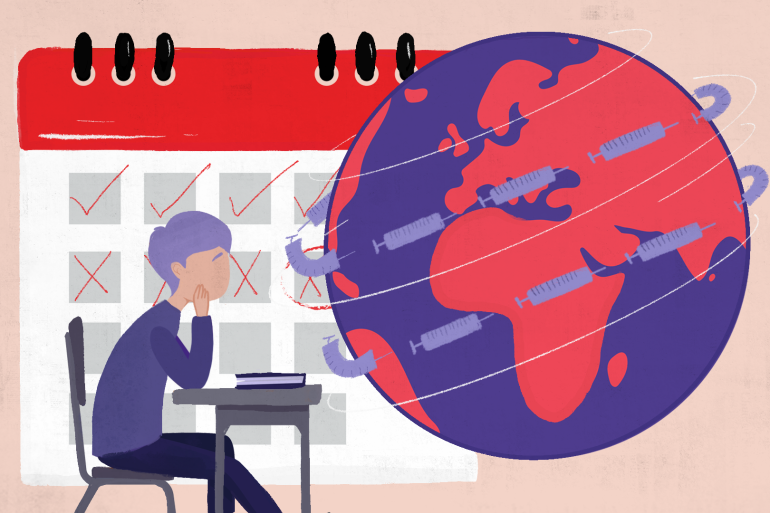NeoCov: What is this virus and should we be worried?
It is important to research this coronavirus that can cross from bats to humans, but we must not panic. Plus, why have child immunisation rates dropped during the pandemic?

A type of coronavirus known as NeoCov has been making headlines around the world, with some comparing it to the SARS-CoV-2 virus which causes COVID-19. But that comparison is not really accurate, and this is certainly not a new variant.
The NeoCov virus is the closest known genetic relative to the Middle East Respiratory Syndrome (MERS) virus, leading to comparisons with the latter’s fatality rate of one in three infected people – but there is no risk to humans from NeoCov yet.
Keep reading
list of 4 itemsIndonesia starts testing homegrown COVID vaccine on humans
What’s needed to defeat Long Covid?
What you should know about COVID reinfections
So what is NeoCov and is there cause for concern?
SARS-CoV-2, MERS, and NeoCov all belong to a group of viruses known as coronaviruses. There are hundreds of coronaviruses, most of which circulate among animals such as pigs, camels, bats and cats. Some coronaviruses can infect humans and cause mild cold-like symptoms. Only three coronaviruses have been known to cause serious symptoms in humans. These are:
- Severe Acute Respiratory Syndrome (SARS) emerged in 2002 and resulted in a highly contagious and potentially life-threatening form of pneumonia. It is thought that a strain of the coronavirus usually only found in small mammals mutated, enabling it to infect humans. Due to a policy of isolating people suspected of having the condition and screening all passengers travelling by air, there have been no new cases of SARS since 2004.
- Middle East Respiratory Syndrome (MERS) was originally transmitted to humans from camels. It was first identified in 2012 and continues to cause sporadic and localised outbreaks. MERS can start with a fever and cough, which can develop into pneumonia and breathing difficulties.
- COVID-19: The SARS-CoV-2 virus causes coronavirus disease 2019 (or COVID-19). It was first identified in China in December 2019 and was declared a global pandemic by the World Health Organization (WHO) on March 11, 2020.
The NeoCov virus was first identified in 2011 and found to infect a species of bats known as Neoromicia, which are mostly found in parts of Africa. NeoCov is not known to infect humans. However, scientists in China who have been studying it caused widespread panic when they suggested NeoCov may have the potential to infect humans in the future.
It is always valuable to research viruses that have the potential to cross between animals and humans but, in the current climate, it is vital to not be alarmist about it.
The study shows that NeoCov can bind to receptors on the outside of bat cells called Angiotensin-converting enzyme 2 (ACE2) receptors to gain entry and cause an infection. ACE2 is a receptor protein on lots of different types of cells that provides an entry point for coronaviruses to bind with and gain entry into an organism. Although ACE2 receptors occur on human cells too, they are different to bat ACE2 receptors and NeoCov is unable to bind with them and infect humans.
But the authors of the paper have suggested that with the correct mutation, NeoCov could potentially spill over into humans. They have gone on to identify the single mutation that would be needed on the NeoCov receptor’s binding domain for it to achieve this spillover event, but only in laboratory settings. Because of its genetic similarities to MERS, this led people to believe if it did infect humans, it would have a similar fatality rate of one in three, but all of this is hypothetical. The researchers also found that antibodies to either MERS or COVID-19 would not neutralise the NeoCov virus.
At present, however, there is no need to panic. It is always a good idea to expand our scientific knowledge of the thousands of coronaviruses out there and prepare ourselves for any potential spillover events that might occur between animals and humans. However, caution must be advised as we study animals, microorganisms and viruses – we must treat them with the respect they deserve; this is the natural world we are dealing with and it does not always play by the rules of humans.
Update: Childhood immunisations rates drop during the pandemic
Childhood immunisations are one of our biggest public health success stories, significantly reducing the numbers of children infected by diseases like polio, typhoid and measles worldwide. But the global pandemic has thwarted efforts made by healthcare professionals to give these life-saving vaccines to children. The WHO reported that global coverage from all childhood immunisations dropped from 86 percent in 2019 to 83 percent in 2020.
An estimated 23 million children under the age of one did not receive basic vaccines, which is the highest number since 2009, and the number of completely unvaccinated children increased by 3.4 million.

A study also showed that the COVID-19 pandemic caused a worrying decline in the uptake in childhood immunisations across Africa, Asia, North and South America and Europe, stating that those from disadvantaged backgrounds and poorer countries were worst affected.
The reasons behind the decline in immunisations are complex and will vary from country to country, but there is no doubt the burden put on healthcare systems during the pandemic played a part. While most wealthier countries continued to invite children in for routine immunisations, poorer nations struggled. Some parents may not have deemed it safe to take their child to a healthcare setting during a pandemic for fear of catching the virus. And, of course, anti-vaxxers will have used any advantage they had around the debate over COVID-19 vaccines to flood the internet with unfounded claims about routine childhood immunisations.
When immunisations do such a good job at eradicating serious illnesses, people often forget how severe these illnesses can be. Measles is a good example – children are vaccinated against measles in the MMR (measles, mumps, rubella) vaccine. They get two doses of the vaccine, which offers 99-percent protection against measles.
Measles is an extremely contagious disease – nine out of 10 unvaccinated children who are exposed to the virus will catch it. It not only causes a widespread rash and fever in the acute phase of the infection but can lead to life-threatening pneumonia in children and cause potentially fatal inflammation of the brain.
For measles to be reduced to safe levels in a population we need 95 percent of the population to be vaccinated against it. The remaining five percent who have not had the vaccines should really only be made up of people who cannot have the vaccines for medical reasons such as allergies or serious illness. These people rely on the rest of us to get vaccinated to allow for a population to achieve herd immunity.
When MMR vaccine rates fall below 95 percent, this can lead to community outbreaks of measles, putting unvaccinated and clinically vulnerable children at risk.
All the vaccines deemed necessary in childhood were developed and recommended because the illnesses they protect against can cause significant suffering and death among children and adults. Millions of doses of these vaccines have been given to children over the years and they are safe. If you have any questions, speak to a healthcare professional. It is never too late to come forward for missed vaccines; we have “catch up” programmes that mean we can get you fully vaccinated no matter which vaccine you may have missed.